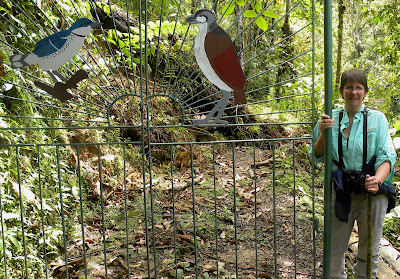Altitude: 13,700 feet a.s.l.
Ecoregions: High Elevation scrub, Polylepis Forest, Paramo
New Hummingbird Species Seen: Ecuadorian Hillstar, Viridian Metaltail, Rainbow-bearded Thornbill
 |
| Papallacta Pass birding requires winter clothes. |
We have finished our time at the lodges of San Jorge and are now heading down the East slope of the Andes. Today we explored a high altitude habitat and the birds that live there with Roger Ahlman as our guide. The Papallacta Pass is a famous birding area as well as the main route across the Andes from Quito to the east. There is a new paved road and an older dirt one where we spent most of our time. The weather is foggy, cold and wet. Balancing a camera, umbrella, and binoculars while wearing winter gloves is a new experience for me.
 |
| Papallacta Pass is the continental divide. Water on one side flows to the Atlantic, the other, to the Pacific. |
Winter comes every night on these mountain tops. So, how do these tiny birds stay alive in these windy, wet, cold environs? Hummingbirds have an amazing ability to decrease their body temperatures and drastically slow their metabolism at night. This voluntary hypothermia is called torpor. They can reduce their body temperature by 30-500F as their body systems slow to just above death. Then, at sunrise, their body temperature begins to climb and the hummers awaken. High altitude hummers are not the only ones to use this torpor state – but they need it more often than their lowland counterparts.
 |
| Paramo vegetation was stunning and stunted. |
To find the high altitude hummingbirds we need to spend time in the stunted Paramo which has lots of flowers this time of year. Paramo is the Spanish word for “desolate territory”. This habitat is located between the treeline and the snowline. It is otherworldly in the misty clouds. There are hummocks of vegetation and water running everywhere. Every rock has an amazing miniature forest of lichens, stunted vascular plants, mosses and tiny alpine flowers. The plant we are on the lookout for is called Chuquiragua.
 |
| I am proud to say that we CAN find hummingbirds without feeders! |
After a few stops we find patches of these orange flowered thistle like shrubs and catch a few glimpses of the Ecuadorian Hillstar. I am pumped to see this high altitude hummer which is so emblematic of the Ecuadorian paramo. We stop for lunch at a ranger station and Roger points out the nest of this bird under the eaves. Hillstar nests are thick and well insulated with woolly down from some fuzzy paramo plant. Keeping naked baby birds warm in this harsh environment must be a challenge.
 |
| The well insulated nest of an Ecuadorian Hillstar. |
During an especially hard downpour we spot a Rainbow-bearded thornbill perched on a low shrub. This is one of the birds I was really hoping to see. It truly has a rainbow beard under its’ very short bill. Another short billed hummer we saw moving around low to the ground was the Viridian Metaltail. Many of these high altitude hummers seem to have shorter bills, bigger bodies, and tend to cling to plants instead of hovering. These short bills are good at probing the smaller alpine flowers and catching the insects that supplement their nectar diet. Saving energy and keeping warm are two important abilities when living in this harsh environment – thus the bigger bodies and reduced hovering.
 |
| A family of Paramo Fox wandered across the road. |
|
 |
| More high altitude habitat at Cayambe Coca National Park. |



















































